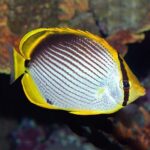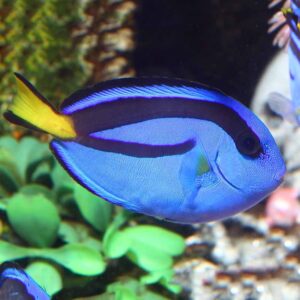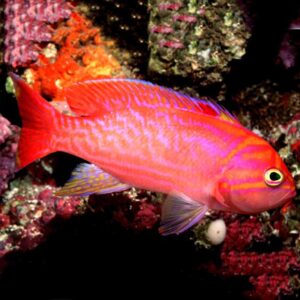Description
The Yellow Pyramid Butterfly (Polylepis) can reach a maximum size of around 8 inches (20 centimetres) in length. It has a distinct triangular-shaped pattern with a vibrant yellow colouration.
Natural Habitat:
The Yellow Pyramid Butterfly is typically found in the clear, tropical waters of coral reefs. It inhabits reef slopes and outer reef areas, where it can be observed swimming in small groups or pairs. Its natural habitat is characterized by rich coral growth, providing shelter and a diverse range of food sources.
Keeping the Yellow Pyramid Butterfly Healthy:
The Yellow Pyramid Butterfly requires a moderate level of care and is considered moderately difficult to maintain. It thrives in a well-established aquarium with stable water parameters. The tank should have a minimum capacity of 75 gallons (280 litres) to provide ample swimming space. Regular monitoring of water quality, including temperature, salinity, and pH, is crucial for the well-being of this species.
Special Requirements and Feeding:
The Yellow Pyramid Butterfly are omnivores. They feed on various types of filamentous and macroalgae in the wild, as well as on invertebrates. In the aquarium, it should be offered a varied diet consisting of high-quality marine flake or pellet foods, supplemented with fresh or frozen algae-based preparations. Providing occasional meaty foods such as brine shrimp or mysis shrimp can also be beneficial.
How Many Should I Keep:
It is recommended to keep the Yellow Pyramid Butterfly in pairs or small groups, as they are naturally social fish. However, the size of the aquarium should be considered to provide sufficient space for multiple individuals. A larger tank with multiple hiding places and territories is ideal to reduce aggression between conspecifics.
Lighting Preference:
The Yellow Pyramid Butterfly prefers moderate to high lighting levels in the aquarium, as this mimics the bright conditions of its natural reef habitat. The lighting should be provided by a combination of fluorescent, LED, or metal halide fixtures to support the growth of photosynthetic organisms and enhance the fish’s colouration.
Suitable Tank Mates:
The Yellow Pyramid Butterfly is generally peaceful but may display territorial behaviour towards other butterflyfish or similarly shaped species. It can be kept with other peaceful community fish, such as tangs, angelfish, and wrasses. Caution should be exercised when selecting tank mates to ensure compatibility and avoid aggressive interactions.
Reproduction in the Wild:
In their natural habitat, the Yellow Pyramid Butterflyfish (Hemitaurichthys polylepis) engages in courtship and breeding behaviours as part of their reproductive cycle. These fish form monogamous pairs and engage in elaborate courtship rituals to establish and strengthen their bond.
During courtship, the pair performs intricate swimming patterns, often involving synchronized movements and displays of vibrant colours. These displays serve to attract a potential mate and signal readiness for spawning. The courtship dance may involve circling each other, rapid fin movements, and even nipping at one another’s fins.
Once the courtship is successful, the pair moves to a suitable location on the reef to spawn. While the exact spawning sites and behaviours of the Yellow Pyramid Butterflyfish are not extensively documented, it is believed that they release their eggs and sperm into the water column, where fertilization takes place. This type of reproductive strategy is known as broadcast spawning.
The fertilized eggs, known as embryos, are buoyant and float in the water column. They are carried by ocean currents, which disperse them over wide areas. The embryos undergo a pelagic larval phase, where they are highly vulnerable to predation and environmental factors. During this time, the larvae rely on their yolk sac for nourishment.
Breeding Hemitaurichthys polylepis:
Breeding the Yellow Pyramid Butterfly (Hemitaurichthys polylepis) in captivity is challenging, and the specific details of their breeding behaviour in the wild are not well-documented. However, here is a general overview of the breeding process for butterflyfish in the Chaetodontidae family.
- Set up:
To encourage successful breeding, a spacious and well-maintained aquarium with suitable hiding places and live rock is essential. The tank should have stable water conditions, including a temperature range of 75-82°F (24-28°C), a pH range of 8.1-8.4, and a specific gravity of 1.020-1.025.
- Courtship/Spawning:
Butterflyfish engage in elaborate courtship rituals before spawning. They exhibit behaviours such as chasing, courtship dances, and colour changes to attract potential mates. Once a pair forms a bond, they will engage in synchronized swimming and display increased aggression towards other fish in their territory.
- Rearing:
Butterflyfish are pelagic spawners, meaning they release their eggs and sperm into the water column. The fertilized eggs hatch into tiny larvae called “planktonic larvae,” which drift in the currents for several weeks. During this stage, the larvae feed on plankton until they undergo metamorphosis and settle onto the reef as juveniles.
Sexual Dimorphism:
Sexual dimorphism in the Yellow Pyramid Butterfly (Hemitaurichthys polylepis) is not well-documented, and it can be challenging to distinguish between males and females based on external characteristics alone. In general, butterflyfish species do not exhibit significant sexual dimorphism, meaning the visual differences between males and females are minimal.
Distribution:
The Yellow Pyramid Butterfly (Hemitaurichthys polylepis) is naturally found in the tropical waters of the Indo-Pacific region, including the reefs of the Indian Ocean, Red Sea, and Pacific Ocean. It is not typically bred in captivity as a line-bred strain, and the original fish come from the wild populations of these regions.
Summary:
The Yellow Pyramid Butterfly (Hemitaurichthys polylepis) is a visually stunning fish with its triangular shape and vibrant yellow coloration. It requires a moderate level of care, attention to water quality, a varied diet, and suitable tank conditions. Breeding this species in captivity is challenging, but it involves providing a well-maintained aquarium, observing courtship behaviours, and creating suitable conditions for the pelagic spawning and rearing of their larvae. This species is not commonly bred as a line-bred strain, and the original fish come from wild populations in the Indo-Pacific region.
The Fish pictured here are representative only and the livestock you receive may vary in pattern, coloration, and shape.








